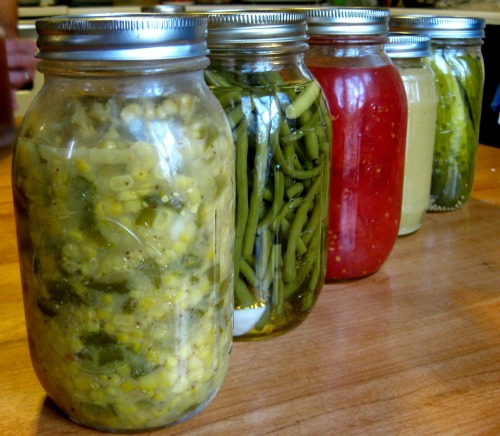 Photo: Anna ZeideFood Studies features the voices of 11 volunteer student bloggers from a variety of different food- and agriculture-related programs at universities around the world. You can explore the full series here.
Photo: Anna ZeideFood Studies features the voices of 11 volunteer student bloggers from a variety of different food- and agriculture-related programs at universities around the world. You can explore the full series here.
You’ve probably already noticed it, but, just in case, I’m here to tell you that home-canned food is hip again. If you don’t believe me, look around: your hardware store is advertising sales on big enamel pots and jar lid lifters, and your friends are stocking their pantry shelves with those beautiful glass jars, this one filled with shimmering red strawberry jam, that one with long green beans floating in a pickled bath of dill flowers and garlic and mustard seed.
Somehow, home canning has transitioned from being the domain of country grandmothers toiling away in kitchens decorated with gingham and rooster prints to popping up in the urban stainless steel kitchens of young foodies and DIY enthusiasts.
This transition, and the changes in Americans’ relationship to food that it suggests, is at the center of my doctoral dissertation, which tells the story of canned food in 20th-century America. Although my dissertation, which I’m just beginning to write, focuses more on industrially-canned goods than on home-canned goods, I think that there are similar issues at play between the early 20th-century excitement about the former and the early 21st-century excitement about the latter.
In both cases, Americans were re-evaluating their relationships with the seasonal and local nature of their food. The main difference is that, around 1900, consumers were trying to break with those shackles of seasonality that limited their food choices, while around 2000, consumers (at least some of them) are welcoming those restrictions as a way of eating locally. How did this come about? How did we get from there to here? In my research, I’m finding that while the answers aren’t always straightforward, they do give us an insight into the very different attitudes toward food that the 20th century, with its rise of industrial agriculture and processed food, has provoked.
One of the common phrases used in the promotional literature of the early canning industry was “Canned food puts the June garden into the January pantry.” One 1914 book, How to Buy and Sell Canned Foods by John Adams Lee, went further, suggesting the power of canned food to obliterate not only time, but also space: “It places the fresh fruits of the tropics on the table of the Laplanders and fresh salmon from the Behring [sic] Sea upon the bill of fare of Havana hotels.”
The fact that food had traveled so far in time and space was touted as a key virtue, in a way that is quite startling to today’s sustainably minded readers. In an era when the ability to ship fresh fruit and vegetables was limited, canned food offered consumers a way to break with seasonal limitations, to eat garden peas in autumn and ripe tomatoes in winter. Canners believed that their technology could overcome the limits of our revolving planet, creating a perpetual harvest. Americans would be able to eat anything, anytime, from anywhere. And who could possibly object to that?
So, it would seem that today, when we can get corn on the cob in the middle of a dark winter, and experience the crunch of an apple in springtime, there would be little need for the miraculous technology of the can. As the early canning boosters promised, we have created a perpetual harvest, albeit with the help of breeding, refrigeration, and shipping technologies, rather than simply cans.
And yet, an increasing number of Americans continue to stock their pantries with preserved foods — though these home canners prefer their glass mason jars to the metal industrial cans (a dichotomy I’ll come back to in future posts). What goes in to these jars is usually local, seasonal food. These are the fruits and vegetables that can be acquired cheaply, in bulk, at the moment of peak ripeness. The reasons cited for this resurgence of home canning — the Canvolution, as some call it — vary: Some say it’s frugality in a time of economic crisis, others that it gives us greater control over our food supply; some that it’s nostalgia for the flavors of grandma’s kitchen, while still others say that it builds community. But many say they preserve their own food because it allows them to eat locally, even when harvest season has long since passed.
Whatever the cause, it clearly indicates a shift in values from those earlier times when a desire to trump seasonal and spatial limitations motivated consumers to buy canned foods. Today, people are producing and eating home canned foods because they’ve begun to think that perhaps it’s worth staying within nature’s limits if it means getting safe, honest food out of the bargain. It’s worth the wait. Maybe it’s even better because of the wait.
Have you tried your hand at canning? There seem to be lots of apples all around these days, and applesauce sure is easy to make. Maybe it will even help you get a little bit of the October orchards into your February pantries.



